A shrew, hunting insects along a stream bank, slips into the icy water. It swims frantically to reach shore, using all its energy to stay afloat.
Just as it appears the small critter might make it, an almost imperceptible ripple appears. And then the water explodes. The surface soon calms, but the shrew is gone. Trout food.
Variations on this theme are favorites in fishing lore, and there are plenty of photos that prove this does actually occur.
But how frequently?
A new article appearing in the journal Ecology of Freshwater Fish suggests this answer: more often than you think.
The paper – by coauthors Peter Lisi, Kale Bentley, Jonathan Armstrong and Daniel Schindler – documents the incidence of rainbow trout and grayling over a 13-year period in the Wood River basin, part of the Bristol Bay watershed in Alaska.
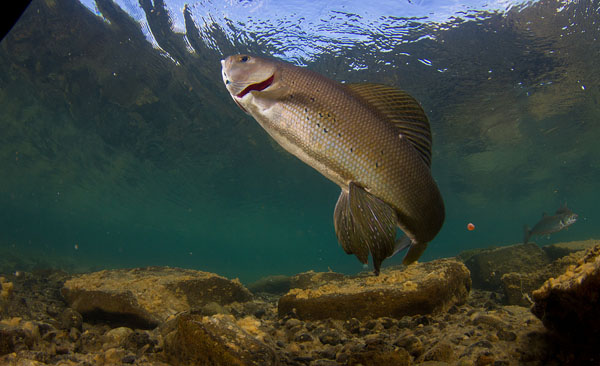
The Shrew Hatch
It’s no secret that trout and other fish will eat small mammals. A year ago, I reported on a rainbow trout with 20 shrews in its stomach, documented during a fish survey at Togiak National Wildlife Refuge in Alaska. It remains one of the most popular stories ever published on Cool Green Science.
Incidences like this are often reported as isolated and opportunistic. Big trout will gulp down a vole or shrew if one falls in, but mammals haven’t been considered a major part of the diet.
This study documents that rainbow trout and grayling actually key in on shrews every two to three years when the mammals may be at peak abundance, much as trout will focus on mayflies or caddis flies when these insects hatch. The small mammals could provide important nutritional value to fish.
In peak years, about 25 percent of rainbow trout and grayling larger than 12 inches had eaten the small mammals.
Peter Lisi, lead author of the study, was working on other fish research while completing his doctorate under Daniel Schindler at the University of Washington (Lisi is now a post-doctoral fellow at the University of Wisconsin-Madison).
The researchers kept finding trout and grayling with shrews in their stomachs. They wondered how often this actually occurred.
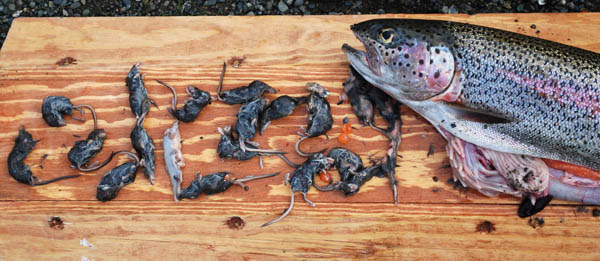
“It became a side research project, something we did out of scientific curiosity,” Lisi says. “How often do these mammals end up in the water? How often do fish eat them? It turns out that every few years in the Wood River basin, trout key in on shrews.”
Shrews are insectivorous mammals that are known to have boom and bust cycles. The researchers speculate that in years of peak abundance, trout and grayling eat them in significant numbers.
“Fish are good at selecting rich prey sources,” says Lisi. “Fly fishers know this well. During a mayfly hatch, if you don’t have the right fly, you’re not going to catch anything, because trout are all focused on a very specific insect.”
How do the shrews wind up in the water? Lisi notes that researchers can only speculate at this point, especially since (unlike trout) shrews are under-studied animals.
A couple of common explanations can be ruled out.
In the Wood River basin, the phenomenon does not appear to be associated with flooding, where small mammals are washed into the stream with heavy rain.
There is a species of water shrew that swims and hunts aquatic prey, but this species is not found in the Bristol Bay region.
In this case, the predation may simply come down to abundant prey near the water.
Lisi notes that they observed some years when shrews were abundant, and that it seemed that during these times shrews were very active along stream banks. The shrews are likely hunting insects and other prey.
“Shrews have a high metabolism, so they have to eat frequently,” Lisi says. “When there are so many shrews, it might lead some to take chances, to hunt close to the edge of the stream or even wade into the stream for aquatic insects.”
The researchers saw shrews crossing very small streams, although some fishing guides have reported that these animals don’t swim very well, making them easier prey for trout.
“Given the incidence of predation we saw, it’s highly doubtful any shrew could make it across a large river,” says Lisi.
One intriguing possibility is that trout also pull shrews off banks, like the orcas that attack seals on beaches in Argentina, or the video-documented cases of catfish lunging for pigeons along water’s edge in France.
Do trout hunt prey in this way? If you’ve seen it, I’d love to hear about it.
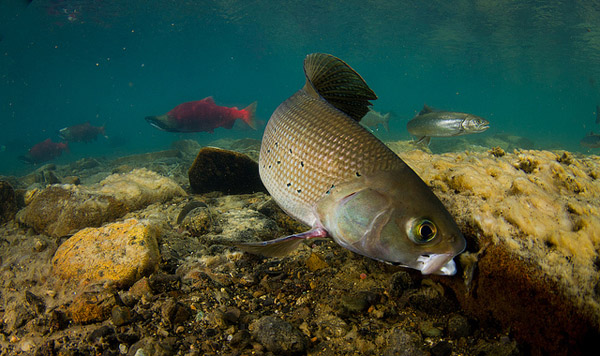
Big Fish, Big Prey
Not all rainbow trout and grayling eat shrews. In part, this is simply because not all trout and grayling can even fit a mammal into their mouths.
Lisi reports that it takes a 12-inch grayling to eat a shrew. But not all 12-inch grayling eat mammals.
Lisi reports that they surveyed grayling in pools where a 12-inch fish was the largest in the pool, and that fish had shrews in its stomach.
Other waters had pools full of 12-inch fish but also contained some larger fish. In these situations, it was only the larger fish that had grayling in their stomach – not the twelve inchers.
“This suggests interesting social dynamics going on here,” says Lisi. “The biggest grayling are excluding the others from eating shrews, and capitalizing on that resource. Often the largest fish had as many as six shrews in their stomachs.”
How often does this occur outside Bristol Bay? There are a lot of reports of fish eating mammals, including trout eating multiple voles at Idaho’s Silver Creek, also covered in a previous blog. In Mongolia, taimen have been found with more than 40 lemmings in their stomachs. That’s right: forty.
But even for highly studied species like trout, there’s a lot we don’t know. Observations by anglers can help a lot in understanding fish ecology and behavior.
Detailed scientific studies occurring over a period of years offer the most valid information — particularly when those studies occur in a healthy, intact ecosystem like Bristol Bay.
There are a number of other studies coming out of Bristol Bay that could shed new light on fish behavior and ecology. I’ll report on more of these findings in the coming months.
In the meantime, keep those stories of “what the trout eats” coming.
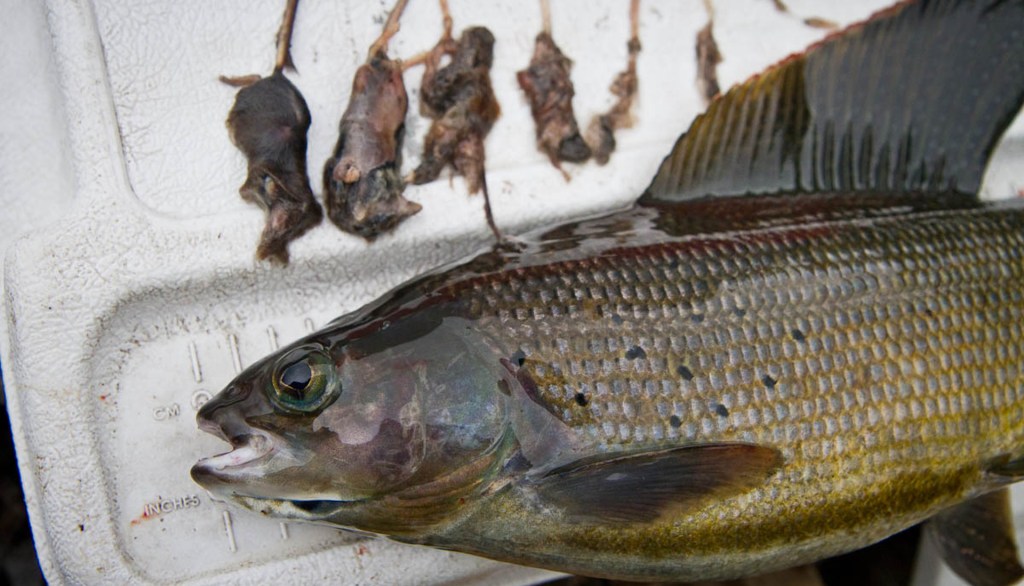

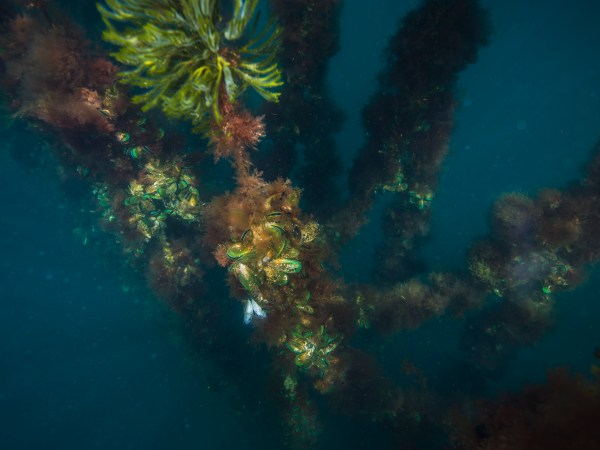

While floating the Sedanka River in Kamchatka Russia with several Russian scientists, they commented that 65% of the rainbow trout and Kundzhas (Siberian white spotted char)diet that they studied was mice. This was late August. Other foods were eggs, insect nymphs and adults, minnows and leeches. Mouse fishing was obviously awesome but dries, streamers, nymphs, eggs and leeches obviously also worked. It would seem to me that there is some migratory instinct for mice, voles, lemmings etc, especially on abundant years, and even if they are poor swimmers, many make the attempt. It seemed on the Sedanka that most of the action was on the north bank, as if the trout were waiting for the mice to come from that direction.
While fishing the Donner and Blitzen River on Malheur NWR in southeastern Oregon, my wife asked me “what mammal with a white stripe would jump in the river and swim around under water?” On further observation it turned out to be a large 24+ inch redband trout with and even longer gartersnake hanging out of its mouth (snake belly out so it looked whitish). We watched it for over a half hour as it worked the snake down while doing laps around the pool. These large fish live in a complex of marches and lakes and probably eat about anything they can fit in their mouth.
David,
That is a wild story and must have been something to see! I have been meaning to get to the Donner and Blitzen River. As you probably know, there is a unique strain of desert redband trout there.
Hi Matt,
I have watched trout in Colorado target ants on stream bank grass. The trout leap out of the water and either grasp the ant off the blade of grass or knock it into the water and feed on it there, most often the latter but hard to rule out the former. Several different trout participated and this went on regularly oven a period of an hour that I watched. The trout ddidn’t beach themselves like the Orcas you mentioned. But they did leap far enough that their bodies were completely out of the water, sometimes by a body length or more and hit the grass and bank(grass was matted down onto the bank) hard enough to knock the ants free. The bank and matted grass rose about 2.5 feet above the water and sloped back moderately. Trout were mainly under 16 inches or so. They seemed to be quite practiced at this tactic.
I live on Canada’s East Coast, and am an avid fly fisher, with various shrew imitations. I’ve had success with this pattern on brown trout most notably, but have caught rainbow trout and even speckled trout with it. In fact, i even hooked a 9-inch brook trout (resident speckled trout), on a shrew pattern tied on a #8 hook (3/4 inch in length). Pertaining to the comment on fish feeding off banks as Orca whales on beaches, this is my most effective way of catching brook trout with a grasshopper pattern in my favourite stream. This stream has grassy banks, and when the water is high I typically will cast to the bank opposite to where I am standing, and try to land the fly 2 or 3 feet into the bank. I will then strip the hopper to the edge of the bank, landing on a reed of grass and pulling it over the water. Trout will amazingly leap up onto the bank and flop toward the pattern, pulling it back into the water!
Here in New Zealand, when the beech trees mask, on average every five years, but lately ,more frequently, the mice population explodes with the heavy fall of seeds to feed on. It the high country , the trout feed on these and increase in body weight .
this year, the beech trees are masking, and double figure trout will surely be caught !!!!
At Montauk State Park in Missouri I once saw a large brown trout come out of the water to knock a mouse, running along a rock wall, into the water. Moments later he came up to finish the job. I went and purchased a mouse lure that I have tried with no success.
Fantastic article, and many thanks for publishing it. In Louisiana & South Carolina I have seen large-mouth black bass eating mice & baby water foul, and my cousin caught a red fish with a garter snake in it’s stomach.
Did you mean to say “grayling in their stomachs?”
Other waters had pools full of 12-inch fish but also contained some larger fish. In these situations, it was only the larger fish that had grayling in their stomach – not the twelve inchers. –
Hi JJ,
Take a look at the Taimen – the fater to all of the salmon and trout.We fished in Russia with mice on a regular basis.The Taimen are most predatory on the mice after they start re-growing their teeth in late summer.Take a look – they are very interesting fish.
Great read !
Bob
Just returned from Alaska on a fly fishing trip and purchased a few mouse flies made from deer hair only my fishing partners laughed me out of using the flies. I’ve read on many blogs that big trout key in on the mouse pattern. Wish I would have tried them as the rain did occur just before our trip. I’ll work these patterns around my local waters now that I’ve read more on the mouse.
Fish eating mammals and other large food sources is not uncommon but well document here. Over the years while fishing or boating I have witnessed ducklings, small muskrats, mice, snakes, and shorebirds attacked and I presume consumed by fish, in most cases by pike, lake trout, bass and walleye. There are many varieties of mouse-shrew-like surface lures that mimic the movements of surface swimming rodents so these findings confirm that hungry fish, including trout will attack just about anything that moves and resembles food.